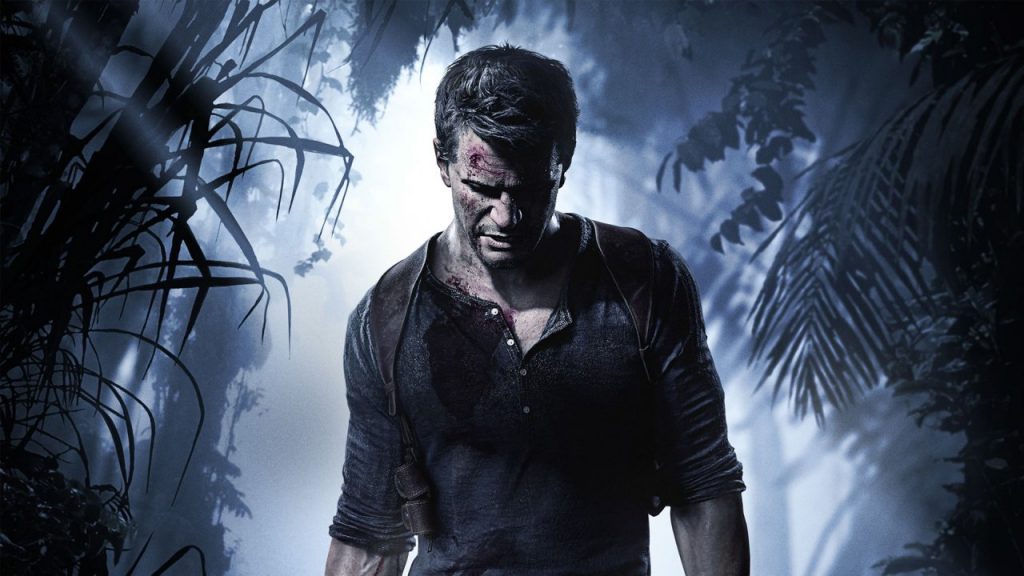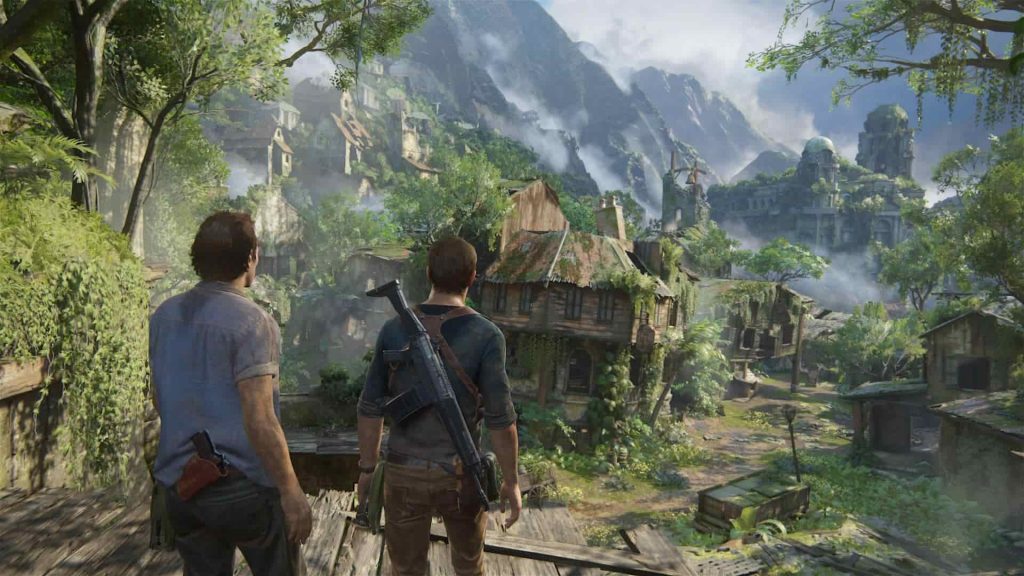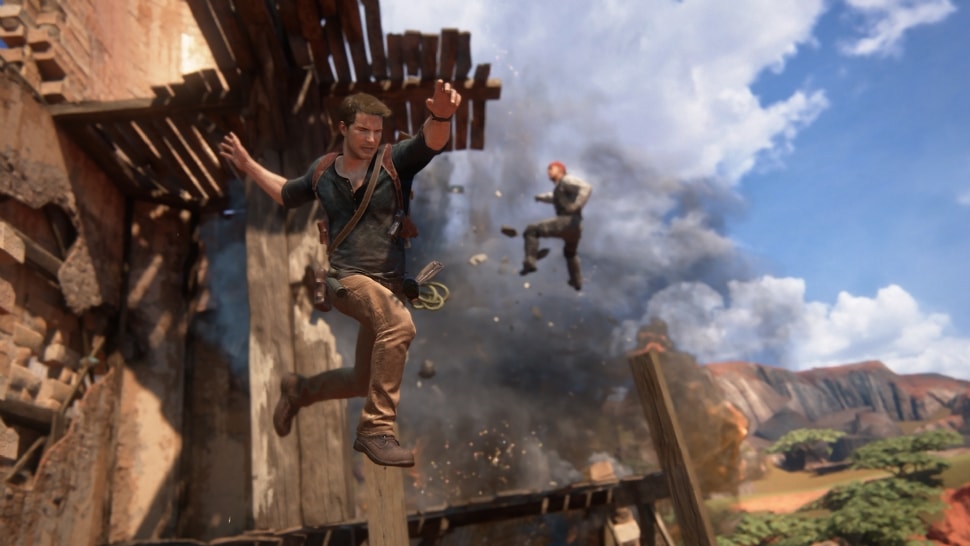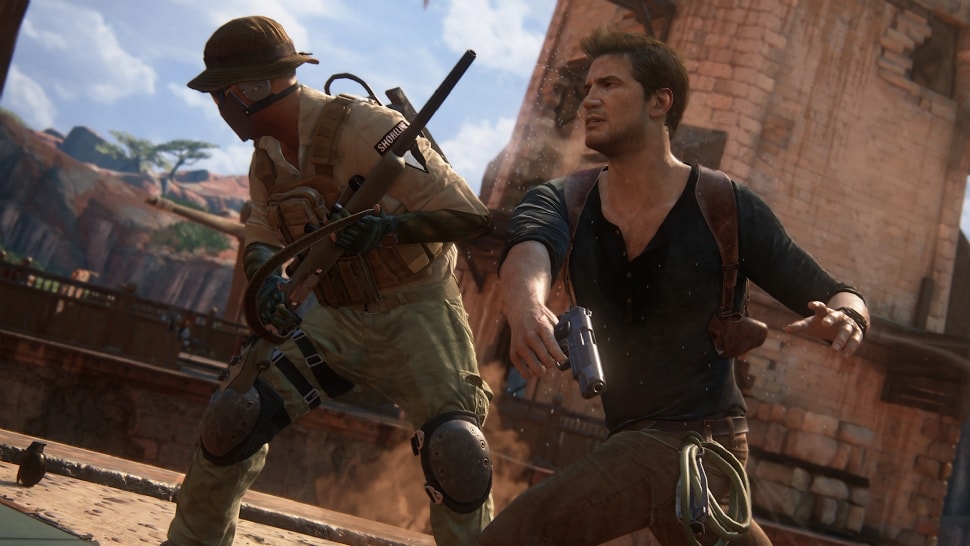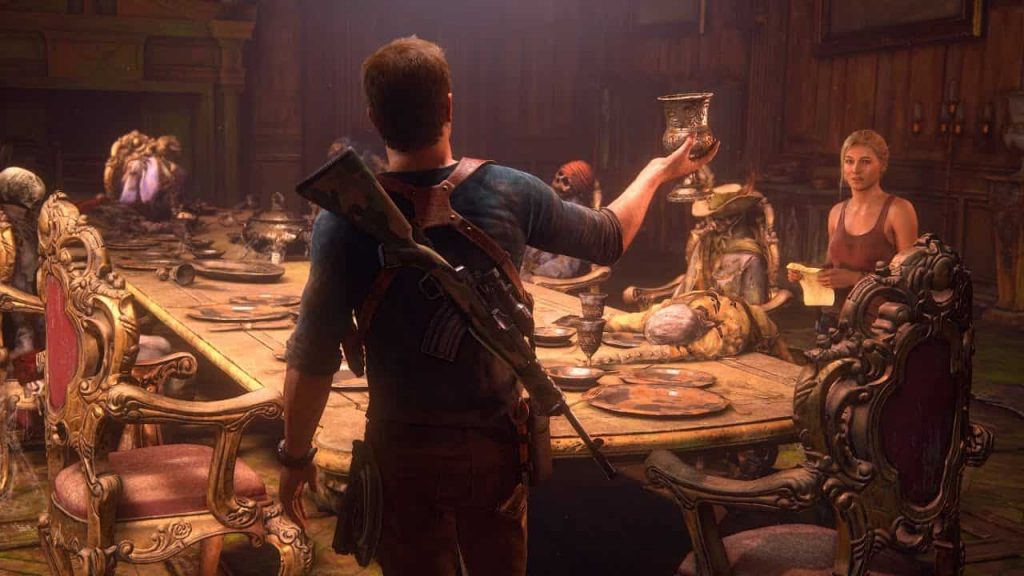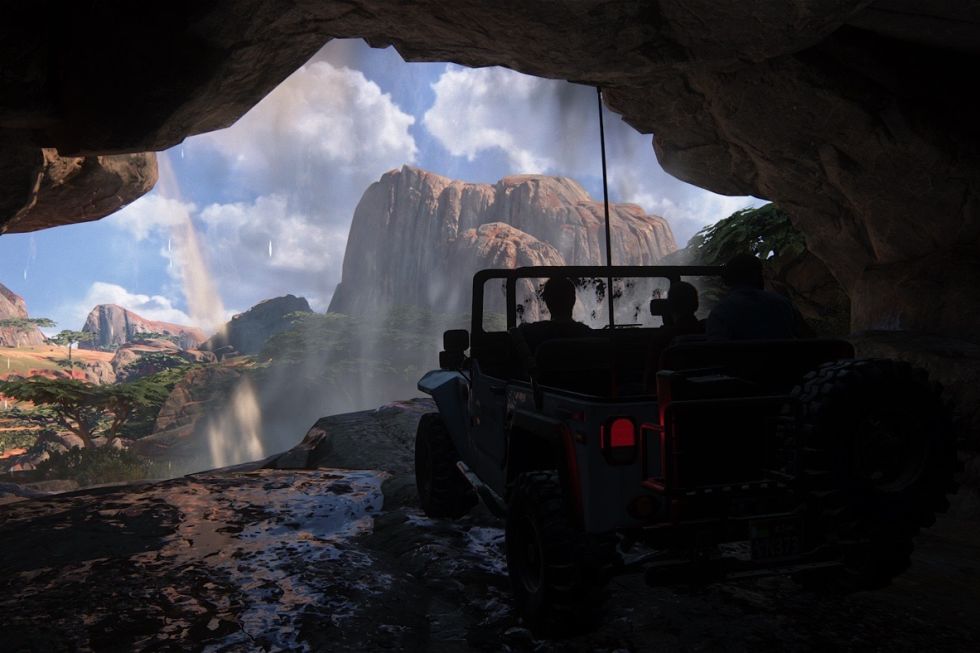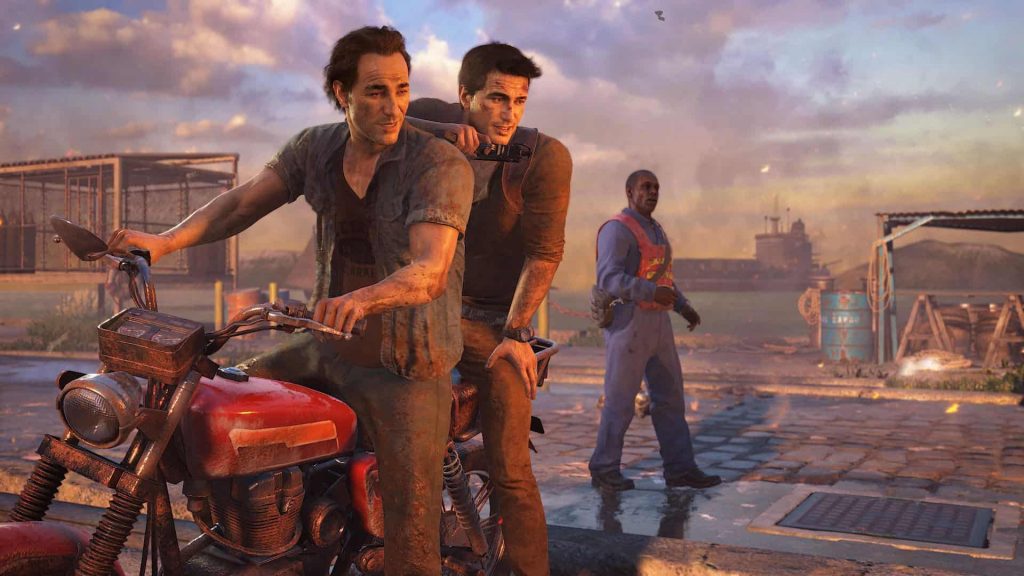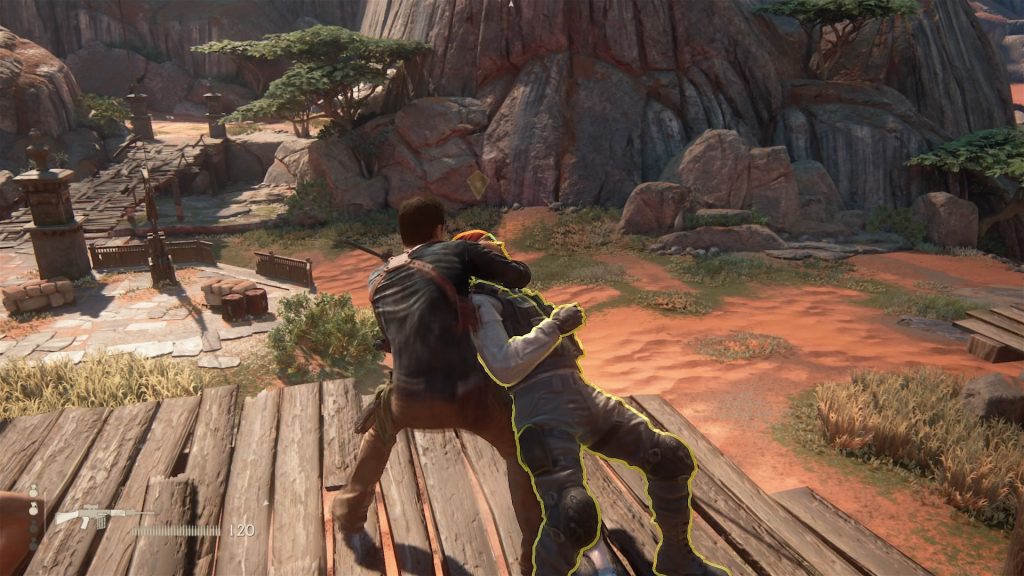In the modern PlayStation era, few franchises are spoken of with such reverence as Uncharted. Nathan Drake’s adventures have set the bar for action-adventure gaming and spawned countless pretenders, but Uncharted’s true legacy is the millions of fans who care deeply about Drake, Sully, and Elena, having followed them for three unforgettable adventures. Uncharted 4: A Thief’s End is the final adventure, and a game about legacy–about what’s worth holding on to, how we’ll be remembered, and what remains when there’s nothing left to chase.
Characters confront these questions as the game confronts the towering legacy of its predecessors. How could a game, so hyped and so shadowed by the success of its forebears, hope to leave a legacy of its own?
Uncharted 4: A Thief’s End PS4 Review
A Stunning, Once In A Lifetime Adventure
Having seen Nathan Drake’s adventure to the very end, the legacy of Uncharted 4 is clear to me. This is Naughty Dog’s finest creation to-date, a lovingly crafted, wholly satisfying conclusion, and a triumph that stands among the greatest games ever made. Such words don’t come lightly, and some of the biggest names Uncharted 4 must live up to are its own predecessors. What resembles a familiar adventure on the surface quickly becomes a surprising journey, with epic discovery and intimate character moments in equal measure.
Seeking Fortune
At the close of Uncharted 3, Nathan Drake turned the page on his treasure-hunting days and walked into the sunset with the loved ones worth keeping over his death-defying life. In Uncharted 4, it’s a loved one who pulls him back in. Long thought to be dead, older brother Sam appears in dire straights after 15 years of absence. He has a life debt to someone who’s eager to collect, and the only way to guarantee his safety is to find the treasure of a lifetime: pirate captain Henry Avery’s sixteenth-century hoard of gold and jewels valued at $400 million.
On paper, Sam’s entrance to the series seems like a left-field play, but with stellar writing and direction, the game’s brief opening sections are able to establish a lifelong relationship between Sam and Nathan. It isn’t long before Sam enters Nathan’s modern life and asks Nate to help save his own, but by the time he does, their emotional connection and shared past are remarkably clarified.
This deepening of character is felt across the entire cast. It’s a slimmer group than in Uncharted 2 and 3, but for the better: everyone is given additional screen time to develop, and the quality of writing and performance behind them has never been better. Nuanced facial animation conveys doubt, false bravado, and unspoken love. By game’s end, all the personalities we’ve been with since the series’ beginning are fulfilled by satisfying, emotionally resonant character arcs.
Believability isn’t limited to Sam and Nathan’s relationship or the way other characters develop. In the adventure at large, great pains are taken to make the quest for Avery’s pirate treasure seem historically feasible and logical. Drake’s past quests for El Dorado, Shambhala, and Iram of the Pillars were well-explained, historically grounded affairs, but some suspension of disbelief was always required. Did ancient pioneers really construct such elaborate machinery and environmental puzzles? How have entire lost cities gone undiscovered in the modern age?
A Thief’s End still asks for a few such generosities from the player, but Naughty Dog gives surprising, thorough consideration to the details. If a keen-eyed player goes looking for them, he’ll find more pieces falling into place than usual. The difference is a story that doesn’t feel impossible, merely unlikely; a fantastic adventure in the Uncharted tradition that still manages to feel believable. Perhaps more important to the game’s legacy, it’s a journey rife with interesting history and plenty of narrative movement that still manages to be easy to follow. The feelings imparted along the way (and at game’s end) are more powerful for it.
Beyond character development and believability, the adventure boasts absolutely perfect pacing and rhythm. These issues in past games were sporadic and far from deal-breakers; a few too many combat encounters here, some slow padding there. Uncharted 4 trims the fat and replaces with purposeful gameplay, addressing virtually every nitpick one could hold against its predecessors. There are slightly fewer combat encounters, evenly balanced between epic and close-quartered.
Typically, there’s a narrative reason for the shootout, or a way in which the shooting pushes the characters or story forward. Combat is never used for padding, and there are fewer frustrations: the juggernaut, bullet-sponge enemies are few and far between (and more imposing for their scarcity), there are numerous ways to approach one-off threats like snipers, and the foes themselves (not their sheer numbers) present the challenge.
A greater share of the journey is given to platforming and exploration. The latter is perfectly executed at both macro and micro levels. A few massive spaces beg to be explored, and one could add a couple hours to the journey scouring them for treasures and optional conversations. But clever world design, dialogue, and mini-objectives nudge you forward in a way that makes these huge areas feel focused, like natural parts of a linear adventure. At the smaller scale of climbing and platforming, uncertainty makes for more interesting gameplay.
There are dozens of small sections where it’s not entirely clear where you should head, or what the proper way to reach that destination is. Some climbing paths are dead ends. Others just exist as a natural part of the world. With this slight degree of mystery, I approached new sections wanting to get a feel for the space and understand it instead of immediately leaping for the nearest handhold.
The inability to fall into a low-effort rhythm of automatic platforming keeps the non-combat hours interesting and engaging, and just when the game threatens to feel quiet or same-y, a dramatic shift in setting or action maintains the compelling flow. Despite being nearly twice as long as any prior game (my final clock: 15 hours), Uncharted 4 never drags. Without exception, the entire adventure is entertaining and engaging.
Uncharted Territory
An exploratory sense of adventure isn’t the only thing working toward a surprising, entertaining adventure. Uncharted 4 owes a lot to additions, both large and small, that expand gameplay in purposeful ways. Drake’s rope, for example, adds new maneuvers to climbing and combat. By tossing your line and grappling hook at pre-determined latch points, you can swing around that point. A lot of your swinging is used to cross gaps and make death-defying leaps, but many combat environments have at least a couple beams to swing from.
The physics of swinging are easy to grasp, and momentum can be creatively redirected to send you (for example) toward other handholds than the obvious ones, or over enemy heads for a melee strike from above. Some sections even task you with using rope physics to solve puzzles or navigate a particularly treacherous climb, showcasing the versatility of the tool. It’s even tempting to use in stealth sections. You might need the speed of a rope swing to cross a large open space quickly, but you’re extremely visible while doing so.
Stealth has been toyed with by the series before, but here, Naughty Dog beefs it up to be a meaty gameplay portion in its own right. The sensible appearance of combat encounters lends itself to several fights that start with Drake hidden from enemy eyes. The mechanics of stealth include marking enemies to track positions, tall grass to conceal Drake’s movement and enemy bodies, and Drake’s familiar moveset of stealth kills from behind, above, and below. Furthering the cause of believability, there is no dedicated whistle button for luring enemies into the safety of tall grass, and a grenade thrown from hiding won’t necessarily alert enemies to Drake’s exact position.
Your rope even plays into the acrobatics of avoidance. You could theoretically scale a ruined tower, undetected by enemies inside, take out the sniper perched on top, swing away from the structure to kill an outside guard from above, and toss a few grenades back inside to finish the job. Success comes from creatively using the environment to avoid or exploit enemy sight lines and reacting quickly to unexpected movement.
While a couple goofball enemies seemed to miss me in plain sight, this sneaking is tense and immersive. Split-second decisions create moments of badass flow, making stealth and combat enthralling and highly replayable. But if your split-second decisions are the wrong ones, all hell will break loose with raucous gunfire. The importance of stealth in the broader context of combat is tuned perfectly.
On Moderate difficulty, no combat encounter is so difficult or overwhelming that a skilled, decisive player can’t manage the onslaught, but every stealth kill managed on your way to better positions and weapons is truly felt in the subsequent shootout.
The elegance of stealth is matched only by the smoothness of gunplay. Uncharted 4’s shooting is sublime–a return to form after Uncharted 3’s somewhat sluggish aiming. Gunshots crack with mechanical impact as your aiming reticle widens and narrows in response to movement and recoil. Guns feel powerful and unwieldy, but tameable.
Controlled, short bursts pay off with deadly accuracy, but even sustained automatic fire isn’t useless. Hip-firing is valid up close, as covering fire while moving to a new position, and while swinging to close the distance. Smooth animation and responsive movement tie these elements together to elevate the series’ mobile, acrobatic, cover-based shooting to a place of distinction. Whether climbing, sneaking, shooting, or swinging, Uncharted 4 is an unbridled joy simply to play.
For longtime fans, Uncharted goes beyond gameplay: we’re here for an adventure, but we’re equally here for a last hurrah with characters we’ve grown to care deeply about over the years. For more time with our friends before the end, optional conversations are a blessing. These moments, briefly available via a speech bubble over your accompanying partner’s head, can involve simple dialogue about the surroundings, a branching conversation, or soul-searching with a deeper reflection on memories and regrets.
In the grand scheme, this is light stuff; no game-changing character revelations are conveyed through these entirely optional moments. Rather, these are chances to exert our individual, emotional investment back onto the story and eke out a few more moments with beloved characters. I’d argue several of these moments feel mandatory–the character insights are valuable, and the writing and performance is excellent throughout–but their optional nature is nice for repeat playthroughs.
Optional conversations pair with hidden treasures and journal entries to round out the game’s collectables. As ever, Drake’s journal entries reflect his personality in humorous, glib observations on his discoveries. Like the optional conversations, these extra entries contribute in their own small way to the feeling of an utterly complete adventure. The journal itself, typically a visual reference for puzzle-solving, is a bit more involved. Uncharted 4’s puzzles fall right in line with the minor difficulty and complexity of past entries. In that sense, they’re probably the most familiar and least impactful part of this fourth entry, but the journal’s greater role does make for a couple creative standouts.
It feels like momentary pauses while exploring, to better understand the environment and figure out a way forward, replace puzzle-solving breaks to some extent. The frantic rush of combat and blockbuster set pieces is balanced by plenty of low-key moments to stop and think, without an arbitrary puzzle filling that time. Even at scale, in massive environments like a sun-baked Madagascar canyon, the game’s vehicles can be solutions to natural obstacles. Naughty Dog’s meticulous craft, an astonishing eye for detail, is evident in the way characters, objects, and surfaces interact.
A Next-Gen Treasure
The same craft has produced a video game of beauty. Graphically, Uncharted 4 is a masterpiece. In every breathtaking vista and impossibly dense jungle, in the subtle animations that convey unspoken feeling, and in soft lighting layered over crystal-clear textures in gigantic environments, the vision of a photorealistic, immersive world is felt. Uncharted 4’s visual legacy will be the imitators–the developers and games that will strive to approach this technological mastery for years to come.
The impact of this lush, impossibly gorgeous world cannot be overstated. The thrill of discovery is heightened. Character emotions ring with greater resonance. The moment-to-moment action, already empowering in its own right, made me feel an even stronger sense of agency and heightened my emotional response. Uncharted 4’s technical competence isn’t just for looks. This is the very definition of next-generation gaming: the marriage of technology and artistry to elevate the experience of play.
The art direction, in particular, ensures that Uncharted 4’s visuals aren’t wasted on an empty, uninteresting world. Long-lost, mythical settings are made believable by the sheer force of thoughtful detail packed into every space. The same coherence that keeps the story grounded makes different environments feel lived in, undiscovered, ancient, or filled with memories.
With scarcely a glitch in sight and no apparent corner left untouched, the impression Uncharted 4 leaves me with is one of visual perfection. That’s not to say it is perfect, rather that its few flaws (including rare, momentary dips below 30 fps and the single time my game crashed) amount to very little against industry-leading vision and execution.
The orchestral score follows suit, though as a personal preference, it’s not my favorite in the series. Uncharted 4’s story undoubtedly strikes a darker tone than its predecessors. In this way, Henry Jackman’s hybrid score is a good fit, mixing Greg Edmonson’s iconic, triumphant chords from Uncharted 2 and 3 with the contemplative strings and minimalism of Gustavo Santaolalla’s work on The Last of Us. The middle ground that Jackman occupies is compelling, but a bit less memorable. There are standout, unforgettable moments cemented by the quality music behind them, but the score isn’t quite as synced up with intense action or quiet interaction as tracks on either end of the spectrum might be.
Among Thieves
The final go-round of Uncharted multiplayer is a similarly hybrid affair, borrowing competitive elements from modern classics to give competitive longevity to familiar franchise gameplay. Notably, a Bronze-through-Diamond ranking system reminiscent of Starcraft and League of Legends governs advancement up a ladder of Team Deathmatch mastery. Elsewhere, the fast-paced third-person shooting and elegant platforming of single-player is translated almost 1:1 across three unranked modes. Plunder, Command, and Team Deathmatch offer distinct multiplayer flavors with varying emphases on teamwork.
Command hinges most heavily on coordination, as players must work together to effectively capture command sites for passive points while protecting their team’s Captain. Team Captains enjoy bonuses like faster revivals and more downed-state health, and taking down the opposing team’s Captain grants a hefty point bonus. In this mode and Plunder, Uncharted’s analogue to Capture the Flag, unique equipment and consumables make a big difference. Beyond the weapons, mods, and passive Boosters that are commonplace in shooter loadouts, Uncharted 4 asks you to select from various deployables, special weapons, and even NPC sidekicks.
These optional items have various costs. In a nod to Counter-Strike, cash is passively and actively earned throughout a multiplayer match, and quiet moments between shootouts or after death give a chance to spend that cash on your pre-selected bonuses. In my time with multiplayer, none of these special items felt game-changing enough to be broken. NPC sidekicks can be killed with a dedicated assault, and a lousy shot with a Desert Eagle is still a lousy shot. But they can certainly help turn the tables in the close-quartered frays that tend to erupt as teams converge on shared objectives like Command Sites or Plunder’s golden idol.
These items also form the basis for strategies that hint toward an interesting metagame. Mines can be planted on drop-off chests in Plunder to momentarily prevent a score, and bullet-sponge Brute Sidekicks can be spawned strategically to prevent movement through certain corridors or bolster a defense. Players are scored with separate Offense and Support points, clearly marking the contributions of different playstyles at match’s end. Supportive actions like tossing a Revival Kit at downed allies or spawning a Savior Sidekick to supply ammo and healing mark an obvious difference in victory, and it’s encouraging to see the game’s early players embrace unconventional roles.
Character progression is pretty standard, with new weapons and mods locked behind grinding out kills with lesser weapons. A more interesting system doles out a wealth of customization items, including characters and outfits spanning franchise history. Relic points earned from match completion can be exchanged for chests that grant a random unlockable. This is as generous as RNG gets; a loot chest will never grant an item you already have. Uncharted Points, a premium currency, can be purchased and spent on the exact unlockables you want, but Daily Challenges grant hefty sums of Relic points–basically, one unlockable per challenge–in exchange for completing one-off tasks like earning 10 kills with a certain weapon.
The flow of rewards, both from progressing your character and exchanging Relic points, is addicting, and loading times are surprisingly snappy given the (albeit, reduced) visual quality of the maps. Most importantly, multiplayer is exciting and tense in ways that can only be achieved when player-versus-player meets Uncharted’s brand of nimble, acrobatic shooting. The depth of loadout customization and obvious importance of teamwork points to a bright future for fans who want to stick around after the credits roll on Nathan Drake’s final adventure.
A Thief’s End
Nathan Drake’s final adventure. It’s surreal to type those words. The question remains: is Uncharted 4 a worthy conclusion to Drake’s tale? Does the ending, to stories and characters we’ve grown to love, satisfy? When all is said and done, what is the legacy of Uncharted 4, and of the series as a whole?
How the saga is remembered will be known with time. But I can say, in no uncertain terms, that Uncharted 4 is an ending worthy of a PlayStation icon. For Drake and his friends, it offers everything I hoped for and even more than I dreamt for. It’s fulfilling to the highest order, exhaustive in its treatment of characters we won’t see again, and an unrequited love letter from Naughty Dog to the fans that have followed Nathan Drake this far.
I don’t expect everyone to feel the same way about the ending. But if your first memory of Uncharted is pulling the coffin of Sir Francis Drake from the ocean off the coast of Panama, if you hold Uncharted 2’s train sequence among your favorite gaming moments ever, or if the deceptions of Uncharted 3 have brought you to tears, there’s a good chance you’ll find the series’ ending as rewarding and satisfying as I did. Days later, I’m still replaying the game’s final hours in my head, and I’m astonished that I can walk away from a series this good with such a feeling of completeness.
Uncharted is a series for the ages, and Uncharted 4: A Thief’s End is the perfect end to that journey. It is, remarkably, the series’ high point and Naughty Dog’s crowning achievement. But its legacy is two-fold: Uncharted 4 is the ultimate video game adventure. Ceaselessly entertaining and emotionally fulfilling, it’s a cinematic masterpiece in a package for everyone. For fans, it’s nothing short of an instant classic–pure greatness, from small beginnings.
Uncharted 4: A Thief’s End is out now on PS4.
Review code kindly provided by publisher.
